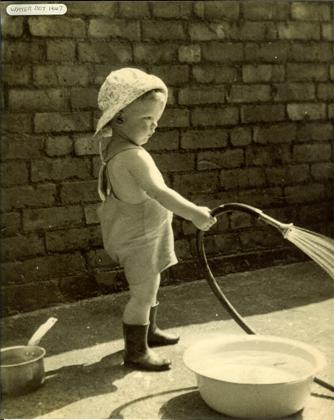The electrically literate may find this somewhat simplified article redundant; or possibly amusing. They should check out Wikipedia for any gaps in their knowledge.
But I hope this will help those for whom Wikipedia is a bit too complicated and/or detailed.

All cartoons from The New Yorker - 1925 to 2004
Think of water in a hosepipe
Electricity is a means of transporting energy from a source, like the wind, to a device you use to exploit that energy, like your electric toothbrush.
The usual way of explaining electricity is to use the simile of the flow of water in a pipe (a current of water). We are all familiar with a hose pipe. Its pressure is analogous to the voltage; and the flow of water is analogous to the current.

The author - almost two - learning about currents and voltage
The work that can be done in an hour, for example if you use the jet to spin a bicycle wheel or push leaves along a path, is the pressure (like Volts) times the current (like Amps) for an hour.
You won’t be able to squirt the water from your hose far if there is no pressure or if there is no water. You need both. If the pressure falls the water ceases to flow.
It’s the same with a stream (current) of electricity making its way down a conductor; for example, a wire. The electrical force acting on an electrical current provides the power to do work.
Most quantities in modern physics are named after an early natural philosopher or inventor. If we had let tradition do it, each would probably be related by some strange number, like the number of feet in a mile; or pounds in a ton. But most new physical values use the decimal system (the rationalised MKS or SI units: meter, kilogram, second).
A Watt is a measure of Power; the instantaneous capacity to do work; named after James Watt.
Under this system we define one Watt as equal to one Volt (electrical force) multiplied by one Ampere (current); or Amp for short. Read More...
Using this simple relationship, you can easily calculate that 1000 Watts of power (one kilowatt) can be carried by a current of 4.17 amps at 240 volts (240 x 4.17 = 1000)
But the same power requires only 0.002 amps at 500,000 volts (0.002 x 500,000 = 1000). So when you turn on an electric kettle or toaster it will draw around 4 amps in your home at 240V but only 0.002 amps in the very high voltage grid to bring it from the generator in the power station.
Power exerted for a period of time is called Energy. Physicists measure energy in Joules (1 J= 1Watt acting for 1 second). But to get to a smaller working number electricity companies like to measure energy in kilowatt hours (1 kWh = 3,600 kJ = a thousand Watts acting for the seconds in one hour)
When your bill comes, you get charged for the Energy, the number of kWh* you used, not Power (kW).

*Terminology: 1000 Wh = 1 kilowatt hour (kWh); 1000 kWh=1 megawatt hour (MWh); 1000 MWh = 1 gigawatt hour (GWH), 1000 GWH = 1 terawatt hour (TWh).
